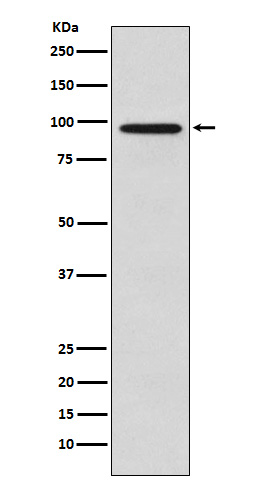Golgin 97 Antibody
Rabbit mAb
- SPECIFICATION
- CITATIONS
- PROTOCOLS
- BACKGROUND

Application
| WB, IP |
|---|---|
| Primary Accession | Q92805 |
| Clonality | Monoclonal |
| Other Names | Gap junction protein alpha 4 37kD; GOLGA1; Golgi autoantigen golgin subfamily a 1; Golgin A1; Golgin subfamily A member 1; Golgin97; |
| Isotype | Rabbit IgG |
| Host | Rabbit |
| Calculated MW | 88184 Da |
| Dilution | WB 1:1000~1:5000 IP 1:30 |
|---|---|
| Purification | Affinity-chromatography |
| Immunogen | A synthesized peptide derived from human Golgin 97 |
| Description | The Golgi-associated protein golgin A1 (GOLGA1, golgin-97) was first isolated as a Golgi complex autoantigen associated with the autoimmune disorder Sjogren's syndrome. The golgin-97 protein contains a carboxy-terminal GRIP domain and is a commonly used trans-Golgi network (TGN) marker. |
| Storage Condition and Buffer | Rabbit IgG in phosphate buffered saline , pH 7.4, 150mM NaCl, 0.02% sodium azide and 50% glycerol. Store at +4°C short term. Store at -20°C long term. Avoid freeze / thaw cycle. |
| Name | GOLGA1 |
|---|---|
| Function | Involved in vesicular trafficking at the Golgi apparatus level. Involved in endosome-to-Golgi trafficking. Mechanistically, captures transport vesicles arriving from endosomes via the protein TBC1D23 (PubMed:29084197, PubMed:38552021). Recognized vesicles are then tethered to the trans-Golgi before subsequent SNARE engagement and vesicle fusion. Selectively regulates E-cadherin transport from the trans-Golgi network in tubulovesicular carriers (PubMed:34969853). |
| Cellular Location | Golgi apparatus membrane; Peripheral membrane protein. Golgi apparatus, trans-Golgi network membrane Cytoplasmic vesicle, secretory vesicle, acrosome {ECO:0000250|UniProtKB:Q9CW79} |

Thousands of laboratories across the world have published research that depended on the performance of antibodies from Abcepta to advance their research. Check out links to articles that cite our products in major peer-reviewed journals, organized by research category.
info@abcepta.com, and receive a free "I Love Antibodies" mug.
Provided below are standard protocols that you may find useful for product applications.
If you have used an Abcepta product and would like to share how it has performed, please click on the "Submit Review" button and provide the requested information. Our staff will examine and post your review and contact you if needed.
If you have any additional inquiries please email technical services at tech@abcepta.com.













 Foundational characteristics of cancer include proliferation, angiogenesis, migration, evasion of apoptosis, and cellular immortality. Find key markers for these cellular processes and antibodies to detect them.
Foundational characteristics of cancer include proliferation, angiogenesis, migration, evasion of apoptosis, and cellular immortality. Find key markers for these cellular processes and antibodies to detect them. The SUMOplot™ Analysis Program predicts and scores sumoylation sites in your protein. SUMOylation is a post-translational modification involved in various cellular processes, such as nuclear-cytosolic transport, transcriptional regulation, apoptosis, protein stability, response to stress, and progression through the cell cycle.
The SUMOplot™ Analysis Program predicts and scores sumoylation sites in your protein. SUMOylation is a post-translational modification involved in various cellular processes, such as nuclear-cytosolic transport, transcriptional regulation, apoptosis, protein stability, response to stress, and progression through the cell cycle. The Autophagy Receptor Motif Plotter predicts and scores autophagy receptor binding sites in your protein. Identifying proteins connected to this pathway is critical to understanding the role of autophagy in physiological as well as pathological processes such as development, differentiation, neurodegenerative diseases, stress, infection, and cancer.
The Autophagy Receptor Motif Plotter predicts and scores autophagy receptor binding sites in your protein. Identifying proteins connected to this pathway is critical to understanding the role of autophagy in physiological as well as pathological processes such as development, differentiation, neurodegenerative diseases, stress, infection, and cancer.


